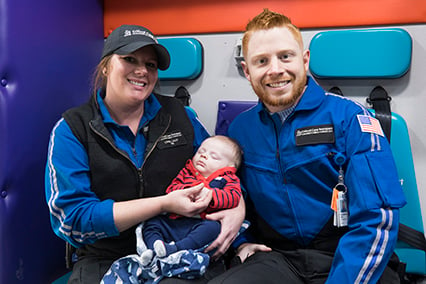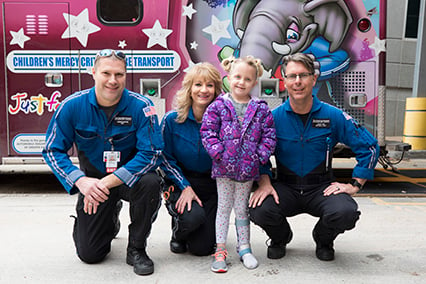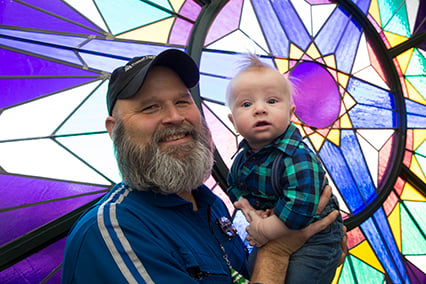Critical Care Transport: Parker's Story
Born six and one-half years ago at only 23 weeks, 5 days of gestation, and weighing l pound, 12 ounces, Parker McElroy’s mother, Kylie, said he is alive today thanks to the Children’s Mercy Neonatal Transport team.
Kylie remembers going into premature labor on July 3, 2012, at Atchison Hospital, Atchison, Kan. As soon as her water broke, doctors knew there was no stopping Parker’s delivery. That’s when they called the Children’s Mercy Neonatal Transport team.
“The plan was to try to keep me from delivering the baby until the team arrived,” Kylie said. “Parker was born as they were walking through the door.”
Once at the hospital, the team went to work, trying to stabilize the tiny infant by establishing an airway.
“They had to do quite a bit of work on Parker before they could transport him to Children’s,” Kylie said. “No one thought he would survive, so they let me hold him for a moment before they left. That meant a lot to me.”
At Children’s Mercy, Parker was admitted to the Neonatal Intensive Care Unit where he spent the next five months of his young life. Though Parker faced one medical complication after another, he defied the odds at every turn.
Today, his health is still very complex. He has cerebral palsy, developmental delays, depends on a gastrointestinal tube for nutrition, has a tracheostomy and is wheelchair bound.
Kylie has become involved with two Patient Family Advisory Councils, one for parents with a child in the NICU, and the other for parents whose child has a tracheostomy. That’s how Kylie and Parker recently reconnected with the flight crew who transported Parker to the hospital originally.
“We were at a trach family reunion and stopped by the Children’s Mercy ambulance so that our younger daughter could check it out,” Kylie said. While she was standing there, Kylie thought one of the crew members looked familiar. It was Tiffany.
“I asked her if she had been on a flight to Atchison six and one-half years ago to pick up Parker,” Kylie said. When she responded “yes,” Kylie introduced her to her son.
“Tiffany remembered Parker and said she had shared his story many times with other team members,” Kylie said. “It was good to know that Parker’s story is still told six years later—that he made as much of an impact on the flight team as they made on us.”
But there was more. They also reconnected with Alex, the crew member who had established an airway so the tiny baby could breathe.
“Alex saved our son’s life. He was our hero,” Kylie said. “Parker is healthy and thriving in spite of all he’s had to overcome thanks to him, and the Children’s Mercy Neonatal Transport team.”
Inside Pediatrics: Zei's story
After a mysterious illness ravages Zei’s lungs and leaves her fighting for life, the critical care team re-invents its life support protocols to push the limits of medicine to give her a chance.
Critical Care Transport: Matthew's story
Following the birth of their son, Matthew, first-time parents Natalie and Phillip Meznar noticed something was seriously wrong. Suffering from breathing issues, the Neonatal Transport team at Children's Mercy quickly transported Matthew to the hospital for care, where he was diagnosed with a rare condition called pulmonary arteriovenous malformation, or PAVM.

Critical Care Transport: Paizlee's story
Six-year-old Paizlee received an injury to the head from a game of baseball that caused her brain to swell. Rushing against time, the Children’s Mercy Critical Care Transport team arrived to bring Paizlee to the hospital in time for the care she needed.

Critical Care Transport: Knox's story
A rare rash and inconsolable crying triggered a St. Joseph, Mo., mom to take her infant to the pediatrician; and then to Children’s Mercy via ground ambulance. Immediate treatment for scalded skin syndrome meant a brief hospital stay for Knox, who is heathy today.
